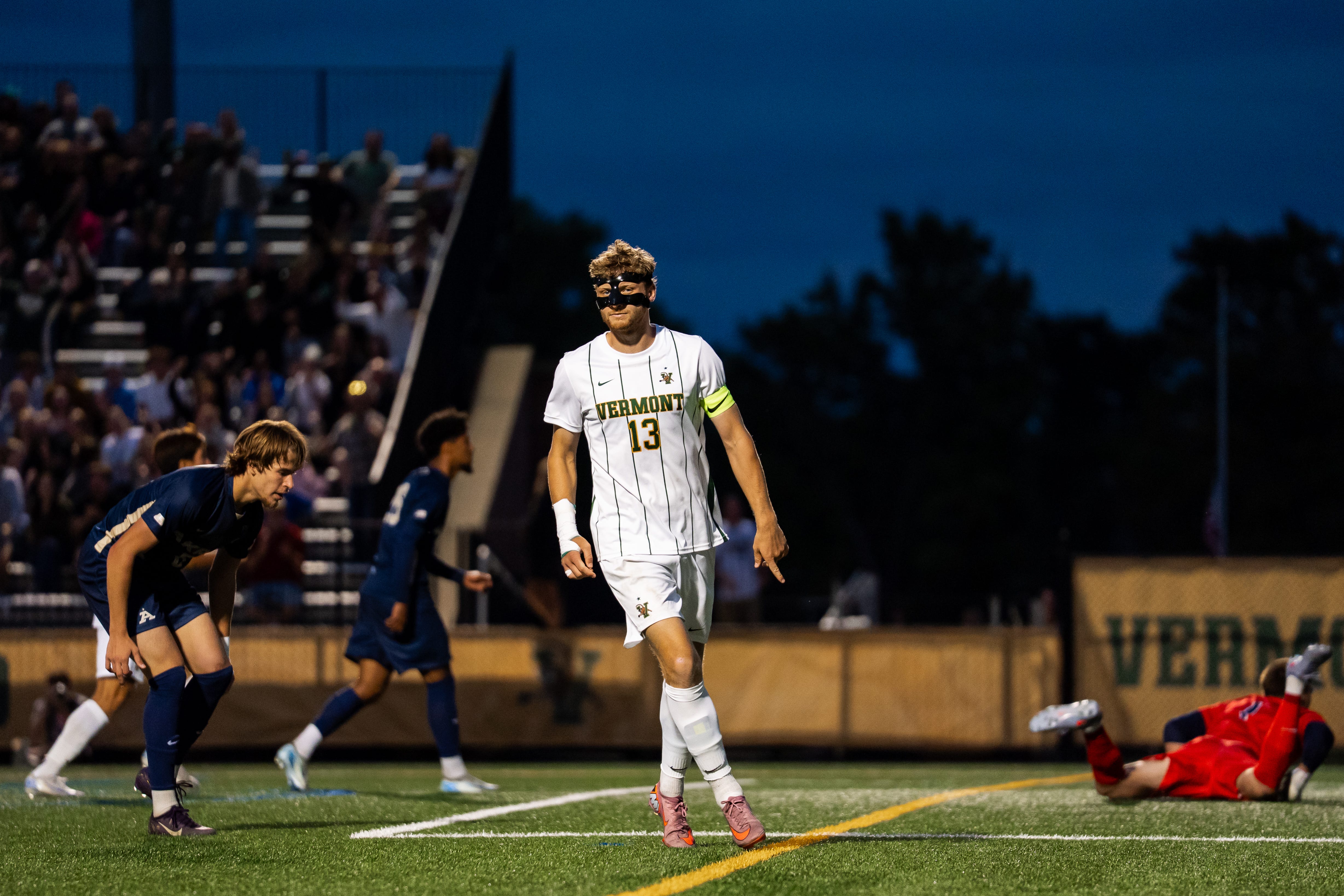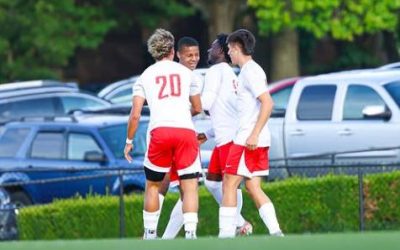Welcome to our Soccer Results Page
View Live soccer results below as well as League and Cup Standings. We also keep detailed past statistics of Leagues, Teams and Players
Today’s Soccer Games
Some of the games from the most popular international competitions as well as the local South African and African competitions
To see many more results, click below
Latest Soccer News
One week after breaking nose and upper jaw, David Ismail scores winner for Vermont soccer

Vermont soccer: David Ismail returns to lead Cats past No. 3 Akron
Back after one game absence due to injury, David Ismail scores the lone goal in UVM soccer’s victory over Akron on Sept. 13, 2025.
David Ismail broke his nose and maxilla, his upper jaw bone, when he was on the wrong side of a bloody collision during Vermont soccer’s victory over Lehigh on Sept. 6.
One week later, Ismail returned wearing a face mask — cleared by doctors on the eve of the No. 13 Catamounts’ nationally ranked showdown vs. No. 3 Akron.
“He’s a father figure within our team. Great leadership, good intensity and ready for his moments,” Vermont coach Rob Dow said. “He’s just a winner.”
And Ismail showed it on the pitch on Saturday, Sept. 13.
Ismail’s volley into the back of the Akron net early in the second half was enough for the Catamounts to blank the Zips 1-0 in front of 2,843 at Virtue Field for the program’s biggest win yet during their NCAA title defense campaign.
It’s also the highest regular-season win over a ranked opponent in team history. The Catamounts improve to 4-0-3 on the season.
“(Doctors) said the risk was OK if I play with a mask. I knew if I was cleared, I was going to play,” Ismail said. “It was the same preparation as any other game.”
After missing a golden chance in the early minutes of the first half, Ismail made amends for his second goal of 2025 with a technically brilliant finish in the 48th minute. In a build-up with pace and precision, Philipp Kuhn laid off a square ball near the home sideline for Ryan Zellefrow, who opened his foot to deliver a pass into the corner for Connor Thompson.
Thompson then uncorked a driven cross into the box for Ismail, who arrived near post on the edge of the goalie’s box to one-time a curling shot to the other side of the net to break the stalemate.
“We talked about it at halftime: ‘Let’s assert ourselves. We are at home, we have the emotion of our community … and let’s continue to put it on them,'” Dow said. “And to score that quick out of halftime is really good identity.”
After needing to rally with a pair of goals in the final 15 minutes to salvage a 3-3 tie with Dartmouth earlier this week, the Catamounts put an emphasis on how “the little things that can equal a result,” Dow said.
“Blocked shots, tracking back, hard runs — guys doing their job,” Dow said. It might not be the most attractive thing, but we are playing good team soccer and we showed that — finally — today.”
Vermont goalie Niklas Herceg turned back three saves for his third clean sheet this fall.
Who’s next for Vermont soccer?
The Catamounts wrap their four-game homestand on Tuesday, Sept. 16 when they play host to Hofstra in a rematch of last year’s NCAA Tournament second-round contest.
Contact Alex Abrami at [email protected]. Follow him on X, formerly known as Twitter: @aabrami5.
.
Men’s Soccer Brings MEC Schedule to Bishop Schmitt Field with Matchup Against Point Park – Wheeling University Athletics

Diego Marquez would lead the Cardinal’s defensive effort in net, making his collegiate debut against the defending champions. In total, he would face five shots on the night, saving four of them, and keeping Wheeling within striking distance. He would face a big push from the Golden Eagles in the final four minutes of the first half and was able to keep the Golden Eagles off the board. He made saves in both the 41st minute and the 44th minute as the teams went into halftime with the 1-0 score holding. He would make back-to-back saves in the 62nd minute to round out his day. He would finish with an .800 save percentage in his collegiate debut and looks to be part of a strong Wheeling goalkeeper group in 2025.
Marquez’s success would not have been possible without the work of the Cardinal’s backline. Pablo Prieto, Ruesca Martinez, and Hallvard Falch would start on that backline and held the Golden Eagles to a .250 shot on goal percentage for the game. After they conceded the first goal of the day, Charleston would put just four more shots on goal the rest of the night as Wheeling pressured the ball. On the offensive side of the ball, Andoni Pipaon continued to step up for the Cardinals, putting one of two Cardinal shots on net. He was the Cardinal’s leader against West Liberty, taking three shots and putting two of those on net, and has taken a team-best four shots, putting three on net over the last two games. He has been the team’s main free kick taker this season and looks to continue to be a strong presence in the midfield.
As they continue their MEC schedule, defense has been a driving factor in the Cardinal’s early season push. Since starting conference play, the Cardinals have allowed an average of 1.00 goals/game, placing them in a tie for second in the MEC with Frostburg State and Concord. Sunday marks one of just two home games for the team over the next three weeks to round out September. It is a part of a stretch that has seen Wheeling play four of their first seven games away from Bishop Schmitt Field. They look to take advantage of their early season chances t home as they push for one of the top six spots in the conference in the battle for the MEC Tournament.
The Matchup
The Cardinals and Pioneers are meeting for the seventh time in program history, with Wheeling leading the all-time series at 4-0-2. At Bishop Schmitt Field, Wheeling holds a 2-0-1 record against the Pioneers, while averaging 1.33 goals/game in those matchups. The Cardinals have come away with at least one point in each of the previous six meetings, including winning two of the last four matchups.
The last meeting between the two teams came on October 20th, 2024, in a match the Cardinals would win 1-0. Leading the way was Antonio Herra-Blackwood, who finished with the lone Cardinal goal of the day while taking four shots and putting two of those on net. Former Cardinal Carlos Molina would get the start in net, making four saves in the shutout, while Jordan Taylor took four shots, putting one of those on net.
The Details
Kick-off for Sunday’s game is scheduled for noon at Bishop Schmitt Field. You can watch the game live by clicking HERE or follow along with Live Stats by clicking HERE.
.
Women’s soccer extends winning streak to four with victory at Northwestern – St. Olaf College Athletics
History
ROSEVILLE, Minn. – The regionally-ranked St. Olaf College women’s soccer team extended its winning streak to four games with a 3-1 non-conference road victory over the University of Northwestern-St. Paul on Saturday evening at Reynolds Field.
Junior Roxanne Rundle and sophomore Rachel Anderson scored in the opening 20 minutes to get St. Olaf (5-1-0) out to a 2-0 lead, but Northwestern hung around and got a goal from Haley Mersberger in the 80th minute to make it a one-goal game. Junior Wren VanDeWalker sealed the victory for the Oles, who were ranked No. 6 in the United Soccer Coaches Region IX poll, with a goal just 2:01 after the Eagles’ tally.
Rundle gave St. Olaf an early lead in the seventh minute by heading the ball in after senior Cat Duffy-Shaw’s corner found the head of senior Marit Klagge in the box and Klagge directed the ball to Rundle. The goal was the second of Rundle’s career and the first since her rookie season.
Anderson extended the Oles’ advantage to 2-0 just over 10 minutes later with her fourth goal in the last four games. After playing a one-two with Klagge, Anderson weaved through multiple Northwestern defenders in the box before slotting the ball into the lower-right corner.
St. Olaf scored on two of its three shots on goal in the opening half. The Eagles nearly made it a 2-1 game at halftime, but Marie Kendall hit the crossbar on a free kick from 40 yards out inside the final minute of the half.
Early in the second half, sophomore Ava Williams rushed off her line to deny Haley Mersberger, who entered the game with 71 career goals for the hosts, and keep St. Olaf’s two-goal lead intact. Mersberger eventually got Northwestern on the board in the 81st minute with a long-range shot from the right side that flew into the roof of the net.
With their lead trimmed to one, the Oles replied just 2:01 later when VanDeWalker picked out the top-left corner from roughly 25 yards out on the left side. VanDeWalker has recorded either a goal or an assist in each of the last three games.
St. Olaf held a 22-8 advantage in shots, including an 11-5 differential in shots on goal, in the game. Williams picked up the victory in her first start of the season with a four-save performance, while Samantha Hansen had eight saves in the loss for Northwestern.
The Oles will open Minnesota Intercollegiate Athletic Conference (MIAC) play at home against nationally-ranked Carleton College at 4 p.m. on Tuesday, Sept. 16.
.
Caselli and Perry Vault Men’s Soccer Past Aurora with 2-0 Win – University of Chicago
History
CHICAGO, Ill. — The University of Chicago men’s soccer team picked up a 2-0 win over Aurora on Saturday night to extend their unbeaten streak and clean sheet streak to four consecutive games.
The Spartans had the first chance to score in the 13th minute when they whipped in a ball from the left side, and Branden Dolezal was able to get a foot to the cross, but Ali Alamery was there to make the save. That shot for Aurora would be the only shot on goal for either side in the opening 45 minutes as the two teams went into the break scoreless.
In the second half, the Spartans once again came out of the locker room with the momentum as they had first three shots of the half, but UChicago was able to draw first blood in the 53rd minute after Sean Cooke played a ball to the middle of the field and Giovanni Caselli beat his defender down the line and buried a one-on-one with the keeper in the bottom corner to give the Maroons the 1-0 advantage. The goal for Caselli was the first career goal for the freshman striker.
Just three minutes later, the Maroons had a chance to double their lead after Caselli laid off a ball in the box to William Stewart, but the Aurora keeper made a diving save to keep the lead at one.
In the 67th minute, the insurance came for UChicago as Samuel Jimenez laid a ball off on the left side to Eli Weene who whipped in a cross, finding the head of Chase Perry for his first career goal, pushing the advantage to 2-0.
Aurora had their best chance to find the back of the net in the 68th minute when the Spartans had a clear strike at the top of the 18 off of a set piece, but Sean Cooke was able to clear the ball off the line for the Maroons to keep UChicago in front.
The Maroons would have several more chances to add to their lead, but they would see out the victory over the final 20 minutes to seal the 2-0 win.
Ali Alamery was a star in goal once again for the Maroons with 1 save en route to his fourth consecutive clean sheet. He is the first UChicago keeper since Will Boyes in 2021 to record four consecutive clean sheets. The Maroons also push their consecutive shutout minutes streak to 423 with the win. This ranks as the 7th-longest streak in the past 15 years and the longest since their 552 minute shutout streak in 2021.
With the win, the Maroons improve to 2-1-2 on the season. UChicago will return to action on Wednesday night as they host Hope College at 6 PM.
.
Boys soccer results for Saturday, Sept. 13, 2025

John Marshall 6, St. Charles/Lewiston-Altura 0
ST. CHARLES — Gustavs Baltavics, Israel Barboza and Lennox Robinson each registered a goal and an assist as the Rockets cruised past SCLA in a non-conference clash.
Eldin Begic, Jonah Ramirez and Elijah Sawatsky each scored as well for the Rockets (6-1-1).
ADVERTISEMENT
Nolan Warmkagathje made 16 saves for SCLA (4-4).
John Marshall 6, St. Charles/Lewiston-Altura 0
John Marshall#4#2#—#6
St. Charles#0#0#—#0
John Marshall: Gustavs Baltavics 1 goal, 1 assist; Israel Barboza 1 goal, 1 assist; Eldin Begic 1 goal; Franklin Melendez 1 assist; Zack Najya 2 assists; Jonah Ramirez 1 goal; Lennox Robinson 1 goal, 1 assist; Elijah Sawatsky 1 goal. Goalie: David Carter 3 saves; Matthias Gabrielson 6 saves.
St. Charles: Goalie: Nolan Warmkagathje16 saves.
Mayo 4, Farmington 2
ROCHESTER — For the second consecutive game, Jack Goin scored a pair of goals as Mayo knocked off Section 1, Class 3A foe Farmington.
Nathan Rea had a goal and an assist, while Sam Thompson scored on a banger of a goal from the top of the box. Alex Zoghby was excellent in the midfield, according to coach Tim Jennings.
Mayo 4, Farmington 2
Farmington#1#1#—#2
Mayo#3#1#—#4
Farmington: No stats available.
Mayo: Amani Gupta 1 assist; Davvian Perales 1 assist; Fionn Pittock 1 assist; Jack Goin 2 goals; Nathaniel Rea 1 goal, 1 assist; Sam Thomson 1 goal. Goalie: Henry Collura 0 save.
Notes: Mayo is 5-1-1; Farmington is 0-6-2.
NON-CONFERENCE
Stewartville 2, Winona Cotter 0
Winona Cotter#0#0#—#0
Stewartville#0#2#—#2
Winona Cotter: Goalie: Ezra Burros 5 saves.
Stewartville: Cole Kropp 1 assist; Lucas Yennie 1 assist; Lukas Nelson 1 goal; Charlie Boerger 1 goal. Goalie: Brocken Rester 6 saves.
Notes: Stewartville is ranked 6th in Class 1A, 10-0 overall; Winona Cotter ranked 8th in 1A, 7-1 overall.
Kasson-Mantorville/Triton 3, Winona 1
Kasson-Mantorville/Triton#2#1#—#3
Winona#0#1#—#1
Kasson-Mantorville/Triton: Sawyer Bendickson 1 goal; Cooper Bebee 2 goals. Goalie: Brady Voss 8 saves.
Winona: No stats available.
Our newsroom occasionally reports stories under a byline of “staff.” Often, the “staff” byline is used when rewriting basic news briefs that originate from official sources, such as a city press release about a road closure, and which require little or no reporting. At times, this byline is used when a news story includes numerous authors or when the story is formed by aggregating previously reported news from various sources. If outside sources are used, it is noted within the story.
Source: https://www.postbulletin.com/sports/prep/boys-soccer-results-for-saturday-sept-13-2025
.
Wooten’s Equalizer Gives Men’s Soccer 1-1 Draw at Connecticut – Harvard University
UConn+ Full Replay
STORRS, Conn. – Sophomore Phoenix Wooten scored his first career goal on a second-half equalizer as Harvard University men’s soccer played to a 1-1 draw at undefeated Connecticut on Saturday night at Morrone Stadium.
After the Huskies (5-0-3) netted the only goal of the first half in the 23rd minute, the Crimson (2-1-1) drew level in the 75th minute as Wooten’s goal helped Harvard remain unbeaten (2-0-1) over its last three matches.
Wooten struck at the 74:36 mark as he drove a shot into the bottom left corner of the goal from outside the penalty area off an assist from junior Dylan Tellado, who posted a point for the third straight match and leads the Crimson with six points on the year.
Over its last three matches, Harvard has earned victories over Big East member Providence, (2-0, Sept. 5) and ACC member California (3-1, Sept. 10) alongside its draw with Big East side UConn (1-1, Sept. 13).
Harvard Highlights
- Sophomore Phoenix Wooten scored his first career goal with an equalizer in the 75th minute. He now has three points on the year on a goal and an assist.
- Junior Dylan Tellado provided an assist on the goal, marking his third straight game with a point. He leads the Crimson on the season with a team-high six points on two goals and two assists. For his career, Tellado now has three assists and 21 points.
- Senior goalkeeper Lucian Wood made one save – a diving stop on a free kick attempt in the 65th minute. He has posted a 0.75 GAA on the season.
- Tellado and junior Andreas Savva each notched a game-high four shots in the match.
- Among the Crimson’s field players, sophomore center back Alexander Castel played the full 90 minutes.
- For the match, Harvard led in shots (15-7), shots on goal (6-2), and corner kicks (8-3). In the second half, the Crimson held edges in shots (8-4), shots on goal (3-1), and corners (4-0).
?? Phoenix Wooten equalizes with the perfectly placed shot! Dylan Tellado with the assist!
75′ | Harvard 1 UConn 1
?? https://t.co/FX0T9kRLil
?? https://t.co/1RmdjpHeY5#GoCrimson #OneCrimson pic.twitter.com/rlUdP50UBb— Harvard Men’s Soccer (@harvardmsoccer) September 13, 2025
?? Lucian Wood makes the diving save on the free kick attempt!
65′ | UConn 1 Harvard 0
?? https://t.co/FX0T9kRLil
?? https://t.co/1RmdjpHeY5#GoCrimson #OneCrimson pic.twitter.com/TILK0lKJ1d— Harvard Men’s Soccer (@harvardmsoccer) September 13, 2025
How It Happened
- The Crimson jumped out to a 4-1 lead in shots in the early going including attempts from Tellado and Savva in the 11th and 14th minutes respectively.
- UConn netted the match’s first goal in the 23rd minute as Charlie Holmes converted from inside the penalty area off assists from Ayoub Lajhar and Preston Alessio.
- Harvard nearly drew level in the 29th minute as Tellado blasted a shot on target from close range that required a diving save.
- In the 35th minute, Holmes received a red card following an attempt at a shot as the Huskies went down to 10 men.
- The visitors nearly equalized again in the 37th minute as Wooten drove a shot on target from distance.
- In the first half, Harvard led in shots (7-3), shots on goal (3-1), and corner kicks (4-3).
- Harvard created chances early in the second half, including a shot on goal from junior Yuta Hata in the 52nd minute and a driven shot from Langenbahn in the 63rd minute.
- Wood made a diving stop to his right on a free kick in the 65th minute, keeping the Crimson within one goal.
- In the 70th minute, Hata was issued a red card following a shot on goal attempt, bringing both sides to 10 men.
- Harvard equalized in the 75th minute behind Wooten’s first career goal off an assist from Tellado. The two players combined for a give-and-go before Wooten placed a shot into the bottom left corner of the goal from outside the penalty area.
?? Dylan Tellado blasts the shot on goal as we continue to battle the Huskies!
29′ | UConn 1 Harvard 0
?? https://t.co/FX0T9kRLil
?? https://t.co/1RmdjpHeY5#GoCrimson #OneCrimson pic.twitter.com/sjURkXOiS3— Harvard Men’s Soccer (@harvardmsoccer) September 13, 2025
?? Phoenix Wooten drives the shot on target from distance!
37′ | UConn 1 Harvard 0
?? https://t.co/FX0T9kRLil
?? https://t.co/1RmdjpHeY5#GoCrimson #OneCrimson pic.twitter.com/cPGiAg3ETe— Harvard Men’s Soccer (@harvardmsoccer) September 13, 2025
Next Up
Harvard hosts the University of New Hampshire on Tuesday, Sept. 16 at 7:00 p.m. (ESPN+) to open a four-game homestand.
[embedded content]
.











